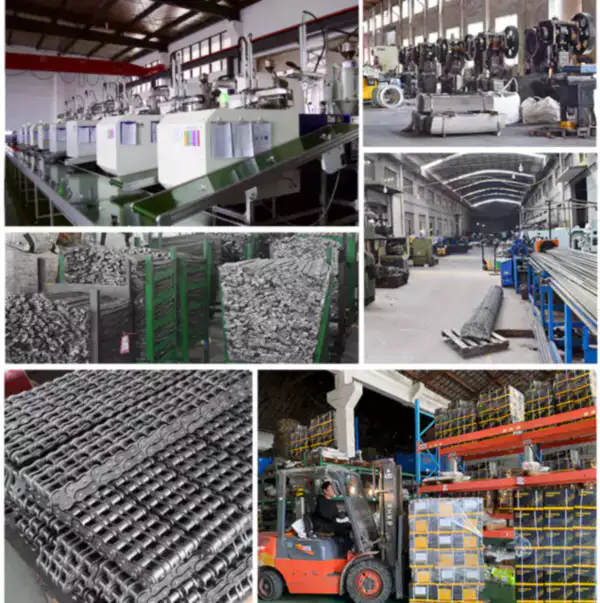Introduction
Static electricity can be a significant problem when it comes to gripper chains. It can cause various issues, including damage to the chains, reduced efficiency, and safety hazards. In this article, we will explore effective ways to address static electricity issues in gripper chains and ensure smooth operation and optimal performance.
Understanding Static Electricity in Gripper Chains
Static electricity is the build-up of electric charge on the surface of an object. In the case of gripper chains, static electricity can occur due to friction between the chain links and the materials they come in contact with. This build-up of charge can lead to several undesirable consequences.

Impact of Static Electricity on Gripper Chain Performance
Static electricity can have several detrimental effects on the performance of gripper chains. Understanding these effects is crucial in finding effective solutions to address the issue. Let's explore some of the key impacts of static electricity on gripper chains:
1. Chain Wear and Damage
Static electricity can accelerate the wear and tear of gripper chains. The electric charge attracts dust and debris, leading to increased friction and chain degradation over time.
2. Product Contamination
Static electricity can cause product contamination in industries that rely on gripper chains. Charged particles can stick to the chains, leading to compromised product quality and potential customer complaints.
3. Reduced Efficiency
Static electricity can create resistance within the gripper chains, affecting their smooth movement and reducing overall efficiency. This can result in slower production speeds and decreased productivity.
4. Safety Hazards
Static electricity build-up in gripper chains can create safety hazards, especially in industries dealing with flammable materials. It increases the risk of sparks and potential explosions, endangering workers and facilities.

Effective Measures to Address Static Electricity in Gripper Chains
To mitigate the issues caused by static electricity in gripper chains, various measures can be implemented. Let's explore some effective ways to address this problem:
1. Humidity Control
Maintaining a controlled humidity level in the production area can help reduce static electricity. Higher humidity levels prevent the build-up of electric charge on the surface of the gripper chains, minimizing its impact.
2. Anti-Static Coatings
Applying anti-static coatings to the surface of gripper chains can significantly reduce the build-up of static electricity. These coatings dissipate the electric charge and prevent its accumulation.
3. Grounding System
Implementing a proper grounding system for gripper chains can effectively eliminate static electricity. It provides a path for the electric charge to flow to the ground, neutralizing its effect.
4. Lubrication
Using appropriate lubricants on gripper chains can help minimize friction and static electricity build-up. Lubrication ensures smoother chain movement and reduces the chances of charge accumulation.
5. Regular Maintenance
Frequent inspection and maintenance of gripper chains are essential to identify and address any static electricity-related issues promptly. This includes cleaning, lubrication, and replacement of worn-out components.

Sprockets for Gripper Chains
Sprockets play a vital role in the smooth operation of gripper chains. They are responsible for guiding and engaging the chains, ensuring proper movement and functionality. The compatibility between gripper chains and sprockets is crucial for optimal performance.

Our Company's Advantage as a Gripper Chains Manufacturer
Choosing us as your gripper chains manufacturer offers several advantages. These include:
- 1. High-Quality Products: We prioritize the production of gripper chains that meet the highest quality standards.
- 2. Customization Options: We offer a range of customization options to cater to the unique needs of our customers.
- 3. Competitive Pricing: Our gripper chains are competitively priced, ensuring great value for your investment.
- 4. Reliable Customer Support: We provide excellent customer support, addressing any queries or concerns promptly.
- 5. Timely Delivery: We understand the importance of timely delivery and strive to meet our customers' deadlines.

Q&A: Frequently Asked Questions about Gripper Chains
Q1: Can gripper chains be used in high-temperature environments?
A1: Gripper chains are designed to withstand a wide range of temperatures, including high-temperature environments. However, it is essential to select the appropriate chain material that can withstand the specific temperature conditions.
Q2: How often should gripper chains be replaced?
A2: The replacement frequency of gripper chains depends on various factors, including usage conditions, maintenance practices, and the specific industry. Regular inspection and monitoring can help determine when replacement is necessary.
Q3: Are gripper chains suitable for food processing applications?
A3: Yes, gripper chains can be used in food processing applications. However, it is crucial to select food-grade chains that comply with the necessary hygiene and safety standards.
Gripper Chains Procurement Guide
| Product | Key Considerations | Supplier |
|---|---|---|
| Gripper Chain Type A | High durability, corrosion resistance | Supplier A |
| Gripper Chain Type B | High temperature resistance, low maintenance | Supplier B |
| Gripper Chain Type C | Customizable, smooth operation | Supplier C |
Edited by Zqq.
